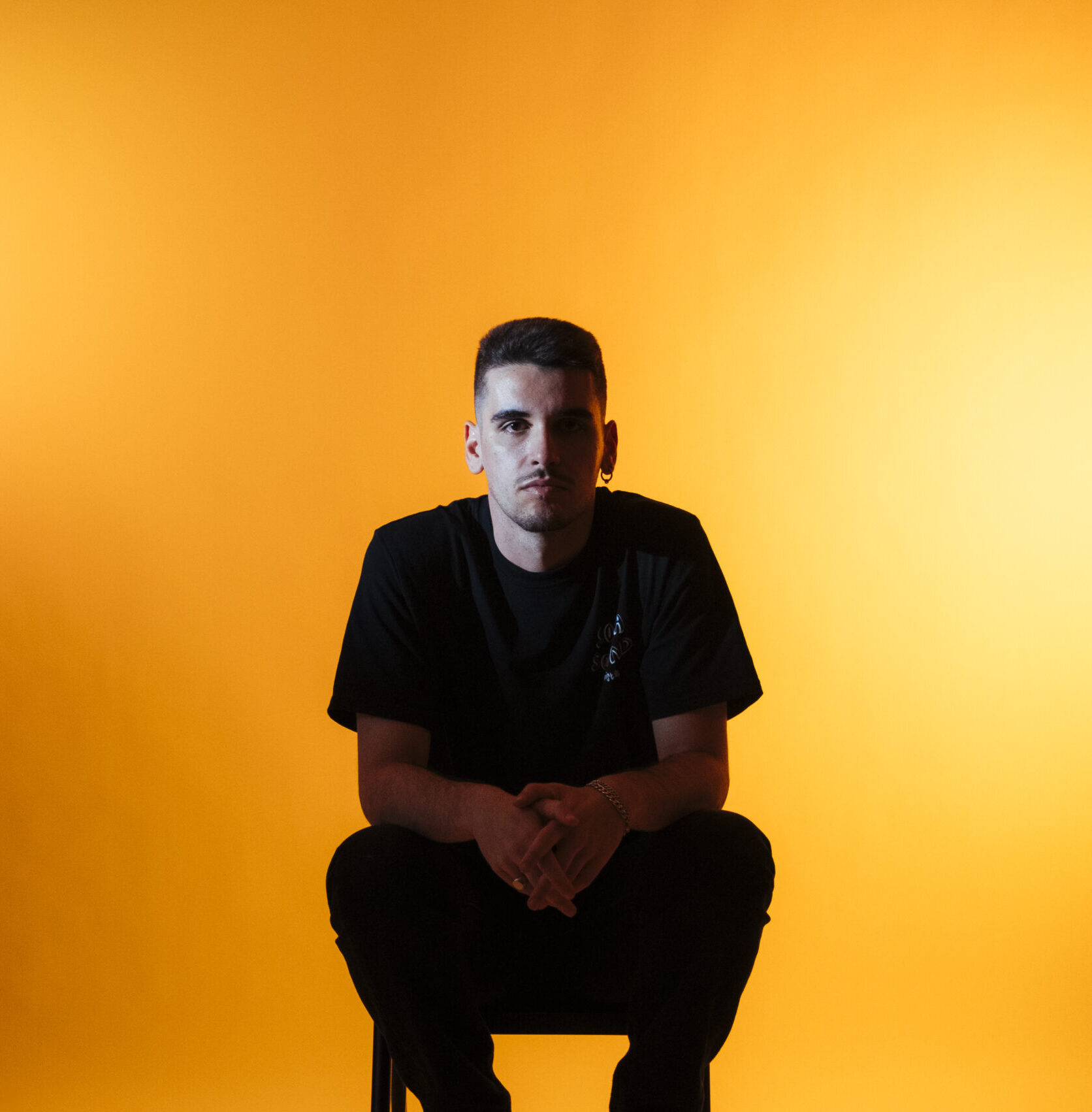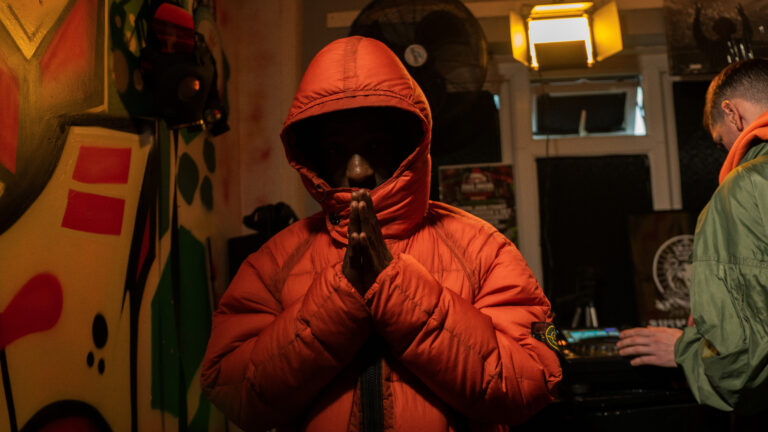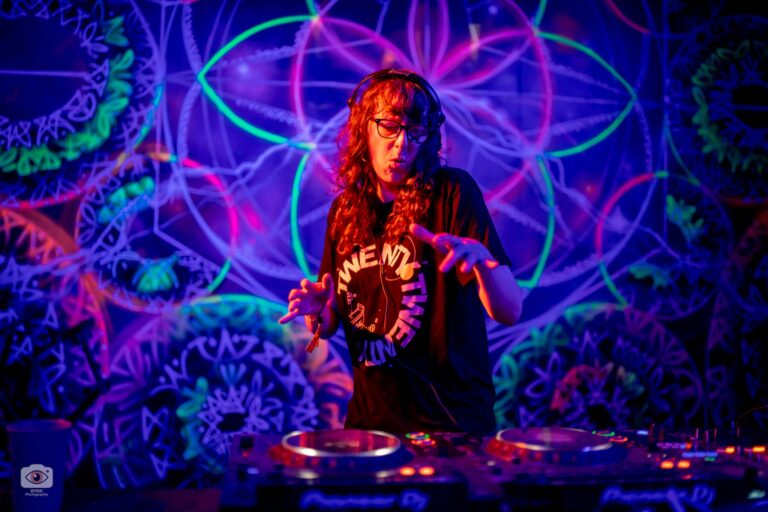Growing up in Porto, inspired by Call Of Duty montages and internet lore – Molecular AKA Rafael Pinto’s introduction to drum & bass was not filled with sneaking into raves, or digging through a friends-older-sibling’s tape pack collection.
It was a steady diet of Noisia, Spor, DJ Die and other legends of that 2010s era, as well as countless hours of YouTube and forums to learn the art of music production – all through the headphones and screens. The culmination of these inspirations and graft shaped Raf’s future, building that trademark funk into his productions today.
On top of the unmistakable groove he purveys, Molecular has become equally renowned for some of the tightest engineering. It’s a combination of talents that’s reasonably rare at this level. But when you think of a satisfying shuffle in tandem with boundary-pushing production – the Bristol names like DLR and Break come to mind, too.
So the question is, how can you take it one step further, in a new direction? As Molecular hits a crucial stage in his music career – the debut album – this has been the mission he’s trying to conquer.
‘Heritage & Sound’ takes inspiration from dub music and culture in a variety of ways, from the more obvious things like samples and effects to the more nuanced details like track arrangement and bass texture. In true soundclash culture fashion, Molecular makes a statement with this new LP. Bringing 12 super-heavyweight tracks to the table that show the world not only his abilities in the studio, but his ability to bring in new elements and establish his own, patented sound…
It’s been a while since we spoke to you. You were still at university at the time. What’s been up since then?
Well, music kicked off! So I didn’t have any time to finish my uni. I’ve only got three or four subjects to go, but I haven’t been there for 2 years now…
The degree was interesting – and I’m very passionate about management and digital marketing. And actually, the marketing subjects were the ones I did the best in terms of grades. I was good at it, and I do take some stuff from it, but a lot of it you can just learn online.
I just got to this point during covid where I didn’t have time – there was so much going on with music, and I was trying to build my Patreon, and build my platform and everything. It started working out so quickly that I realised I could do music full time – not because of royalties, but because of Patreon, allowing me to be closer to my fans and allowing them to support me. So that’s what happened during covid – I quit my job, stopped doing uni, and it worked.
Do you think having that study helped get a head start on the business side of music, seeing Patreon as a good revenue stream for example?
I guess it does help you in the first couple of months. But a lot of the stuff you learn in uni… it’s all theory. You don’t get practical management courses, I didn’t get any internships through uni. You do learn some stuff and it’s cool, but I would say that anyone else without that sort of experience can achieve the same thing, they would just be one or two months behind. They would catch up quickly.
It gives you confidence though. It did for me – I knew I knew the basics of marketing and management so I felt confident to try it. But once you get there, it’s completely different… it doesn’t prepare you very well.
Well take it from someone who has that very same degree you were studying for – I think you might be right.
There’s so much theory – but it’s all basic! You can pick it all up, you know. If you’re smart.
YouTube was my friend, and Reddit. Uni didn’t teach me how to set up my website, or how to sort of my accounting, it was YouTube, Reddit, and forums to understand all these other real life situations.
Was it the same for music then, in terms of how you learned?
It was. I started reading and watching tutorials when I was about 12 or 13 years old. And I think that’s one of the other reasons that I was able to understand English so well – because everything was in English.
I did this music production course – a 6 month course – when I was like 16. But I feel like I already knew pretty much everything. So I guess I’m just self taught on music – pressing buttons, troubleshooting on YouTube, trying things.
How long have you been producing?
I started messing around on FL Studio when I was about 11 years old. But I wasn’t doing anything interesting until I was about 14 or 15. Those first few years I was barely even making loops.
So where did the influence come from to make drum & bass? I can’t say I know of a huge D&B scene in Portugal… I could be wrong!
It’s not huge, it used to be pretty big 10 or so years ago. But now it’s not.
But at that time, I wasn’t going out to raves anyway, so I didn’t catch that ‘train’, if you know what I’m saying. I guess the inspiration came from when I used to play Call Of Duty (COD) – I loved watching the COD montages on YouTube, and they all had D&B tracks on them.
I’d heard of house and techno and things, but this fast music with snares and stuff – it was sick. The first track I heard was The Qemists – On The Run (feat. Jenna G). I listened to that track all day, everyday, until YouTube began recommending me more… Noisia – Block Control… I was hooked. There was no turning back.
There wasn’t really any ‘real life’ situation that pulled me into D&B. It was more of me first finding out D&B on my own, and then starting to look at who the DJs are, and who’s into it around where I live. I then started making some connections locally. But that was way later on, when I was like 16 or 17.
Do you remember wanting to go out and be a part of that ‘real life’ or live rave scene?
Yeah 100%. I remember when I started looking into live sets on YouTube, there were some cool videos – there was this live Break set from like 10 years ago, everyone was vibing, and I would think “I wish this would happen here!”.
So how did you get more involved in it? Was it production that took you there?
Yeah pretty much. I started messaging anyone that was related to drum & bass here in my hometown, Porto. That’s how I met Martim, who runs Counterpoint Recordings. Which is a local label from my town.
When I met him I sent him loads of music, and he said it was not good enough – so I kept trying. I don’t really like to take no for an answer. If you’re telling me no, I want to eventually make you say yes. So I kept sending music, and he eventually wanted to meet up and start releasing the tunes.
At the same time as this, I was meeting a lot of other people who enjoy D&B, just to network and see what’s up. I remember going an hour by train to meet some guy I met on Facebook to spin records because he had decks. It’s like Tinder for D&B.
I love that.
Yeah, it’s really cool, and we’re still friends to this day. I’ve played B2B with him a few times, and he’s still one of my favourite DJs from Portugal.
So anyways, Martim signed some tunes and let me play at some events, so I started meeting more and more people, including the artists we were booking. Jack Workforce, Icicle, and that’s how I met DLR as well. He came over when I was like 19, and that’s how I got introduced to Sofa Sound, J (DLR) said I could send some music, so I did.
You fit Sofa Sound like a glove… that funky, raw, from-neurofunk sound. How did that relationship with DLR tighten once you met him?
So once I met him, I sent him music and he played it. We had a few phone calls about getting releases on Sofa Sound.
He could tell my sound was heavily influenced by him, Break, and the old-school Bristol sound with a touch of neurofunk. I remember him saying the tunes were really cool, but that I should try to do something different, because it obviously sounds a bit too similar. That was 100% true. One thing I like to do as a production exercise is to literally immitate something I like, because that’s a good way to learn. And I remember trying to imitate DLR, Break, Noisia, DJ Die, and all those types of artists.
Up until a couple of years ago, people would say I’m a ‘DLR rip-off’, or I’m ‘DLR’s son’ – I’ve heard that one multiple times. So I’ve been trying to fight this off, and make it obviously different. Running away from the classic ‘wobbly’ sound that he does, that’s so nice and so prominent in Bristol. I’m not going to change my drums, because I love them, so I needed to find where else I could change stuff.
In a way, my latest releases and the album does that. Because I wanted to show people- this is who I am. Although a lot more people are recognising it, I still feel like a lot of people are associating me with DLR, or Break, or The Sauce – so I want to stay away from those and just do my own thing.
That’s a tough place to be. You do want to integrate with Sofa Sound when you’re releasing on it, but you also need to differentiate.
It’s a common issue I’ve been hearing about recently. Alix Perez doesn’t want more Alix Perez’s making replicas of his tunes on 1985.
So what are the key things you’re doing to differentiate?
I try to play around, and create my own samples. The main thing that starts to set me apart now is textures, samples, and the way I’m using basses. I would go with that wobbly bass for a long time – but now I’m trying to go for things like a sustained bass or an 808, and I’m trying different ways of processing it.
It takes me back to the album too – because it’s really influenced with dub and dub music, it’s got like the simplest basslines ever. Three notes, sustained, so there’s no wobbliness whatsoever. There’s a lot of texture and reverb in the bass – and in every sound – in dub music. So I started messing around with these processes on my bass, and just really simplifying the notes. My older tracks would have a lot of notes in the bass, and it’s cool to complicate it sometimes for sure, but I’m just trying to simplify it as much as possible and keep it true to its form. Just drums, bass, simple bassline, good texture, one or two cheeky samples, and that’s the track.
I’ve also been trying different arrangement styles. One thing you can find in the album a lot is just tracks that don’t have a breakdown. It’s just the first drop, and a sort of interesting middle section, but not the typical breakdown where everything stops and it rolls back into the second drop. This is something I take from dub influence too.
Because, in dub – which I believe to be the first electronic music genre ever, back in the 70s, they were the first genre to have the ‘drop the bass’ thing – they had no breakdowns. There might be a section without bass, or without drums, but it’s never really a stop, it would just keep rolling and rolling for 4 or 5 minutes. And they would use effects and texture to simulate that sense of direction, and create that tension you would normally have in a classic 16 bar D&B breakdown.
They would high-pass out the bass, or roll out the drums, doing loads of echoes and things. So I tried to play around with that as well, using loads of effects and textures.
But the drums are a hard one to differentiate – I love my drums and it took me a long time to get them to that level.
Have you been spending quite a bit of time engrossing yourself in dub and reggae recently?
Well when I was a teenager I used to listen to loads of reggae, and there would sometimes be the odd dub track in there. I always knew about dub, but it’s only when I started getting older, is when I started really listening to it and appreciating it. I think my love for dub grew after drum & bass – maybe my brain was able to connect the dots on the similarities or something.
I remember when I was like 19 or 20, I saw this documentary about dub and how it was made. It blew my mind that they could do something like that with only an 8-track mixer, and that they created all these classic effects that we use now – like the dub siren, where they had a tuning button in the mixer that they put some echo on, it and it created the classic ‘bleep’ sound.
A lot of effects that we use now, echoes, reverbs, spring reverbs – that I use a lot in my music – was founded in dub. The texture in dub was crazy, and they did this like 50 years ago!
Dub isn’t something I discovered recently, but I discover more about it every year that goes by, I try to delve a little more into it. I’ve been really into studying recording techniques for drums in dub, like in the 70s and 80s because the drum sound is so amazing. I don’t think I’ll be recording my own drums, but it’s good to know these techniques so I can simulate them.
What’s your favourite track on the album?
The first track, ‘Cold Hands’, was possibly the track I enjoyed doing the most. Because it’s so simple. It started as a tester track for a sample pack that I did. I wanted to test the viability of the sample pack before I sold it. And the drums sounded really nice, and I thought I might as well build it out. It’s one of those ones that wrote itself in like one or two short sessions. And I just kept going back to it and adding sounds and it was just easy.
Then there’s two others – ‘Soundclash’ and ‘Low End Craze’. I like these a lot. Everytime I play them I get such a good reaction, so in a way it’s a couple of tracks that put me in a good place, they make me feel good, so I have a good relationship with them. It’s like me giving myself a pat on the back.
Why did you decide it was time for an album? They’re becoming less and less popular…
Yeah they definitely are becoming less popular. People just want to release singles and that’s what works best for Spotify.
I don’t think people often have the time or attention span to listen to a full album. Even I struggle a lot when one of my favourite artists releases an album – I feel like I can’t give one hour of my time to listen in one go, so I’ll split it over a few days. So I do understand that it’s difficult right now for artists with albums.
But I really needed to make a statement. I wanted to show people: “Here I am, I can write 12 club tracks, with my own sound, takes, and influences”. Going with the culture of sound-clash: “If you can make something better, then prove it!”. Not saying I’m the best or anything, I more just mean that soundclash mentality, proving to people my sound and my ability.
I thought about naming the album ‘my sound’ but obviously that’s Dillinja’s – but that’s where ‘Heritage & Sound’ comes from. Heritage that I take from these other genres like dub, african music, and Jamaican music and culture – this is our heritage that we have in D&B and jungle. We have so much of that influence, and sometimes people forget about it, and just use it without paying any respect to it. And then there’s my ‘sound’ and how I use that heritage, and respect that heritage, to build it on my own sound.
And I guess this is also very much an album for DJs? A collection of rough and ready tracks…
Exactly, just 12 club tracks, like Ed Rush & Optical did with ‘Wormhole’. I might want to do a concept album with interludes and weird tracks some time, but I feel like that’s a lot more difficult to do. Heritage & Sound is really more of a ‘DJ album’. I don’t expect this album to be doing a load of streams for me – I just want this to be a statement for me, I want DJs to play these tracks, and I want people to dance to it.


